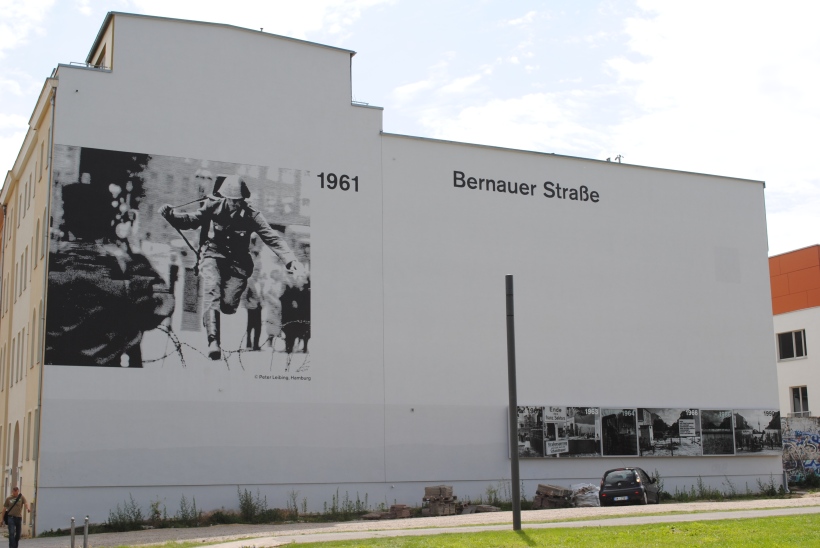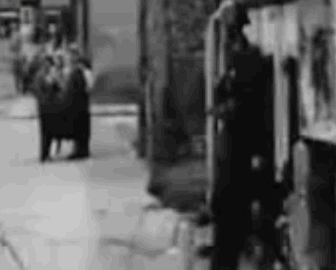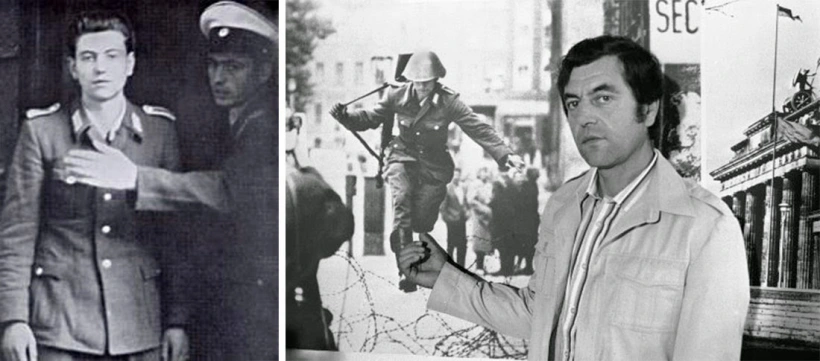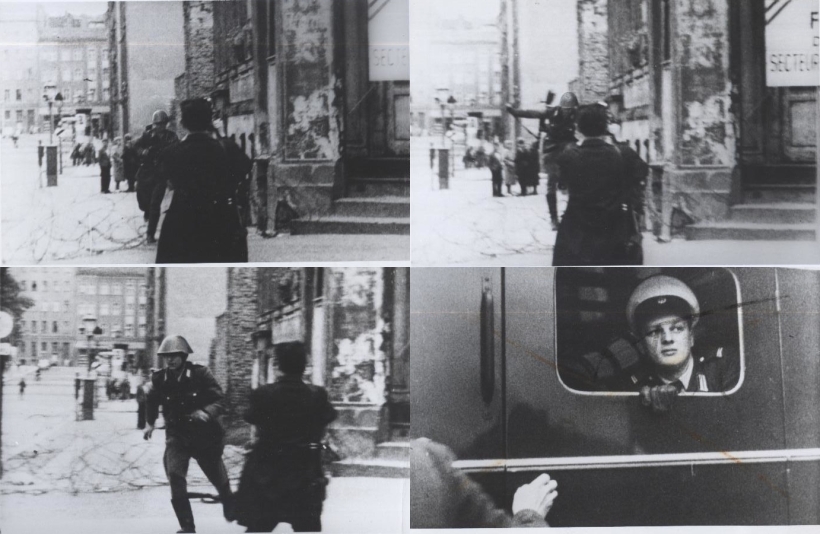
On a cloudy Friday morning in mid-November, I stood under my broken umbrella and stared at the image of the 19-year-old Hans Conrad Schumann leaping over coils of barbed wire.
I’m not sure what captivated me to stand there for twenty minutes, glancing between the ground and the large black and white photograph printed upon the side of the building on Bernauer Straße in Berlin.
On 13 August 1961, the Berlin Wall ‘officially’ started being built. However, it was the preparations made by the Border Guards of East Berlin/GDR which established the foundations for the next 28 years of construction to what would eventually be known in the media as ‘The Wall of Shame’.
After World War II, the four major Allies (the USA, France, Britain and the USSR) forced Germany into demilitarisation as a part of the denazification process of the nation. However, as time went by, it became evident that there was a clear ideological divide between the democratic capitalist nations of the USA, Britain and France and the single-party communist state of the USSR. Despite the insistence of the GDR that no wall was being built, walls no less than three metres high were being constructed to emplace a physical divide between the East and West.
Hans Conrad Schumann was an unwitting symbol of freedom in the Cold War, and though he never regretted the decision to defect from the East, it was a decision which forced him into a life of alcoholism and depression.
On August 15, 1961, 19-year-old photographer Peter Liebing was tipped off by West German police that something would happen upon Bernauer Straße. He had been tipped off as a 19-year-old Conrad Schumann had stood at what would eventually be the Berlin Wall – coils of barbed wire – and pressed down upon it. In a signal to a West German policeman, he gave a sign – the sign to defect.
The situation was dire: as coils of barbed wire were being unrolled, the people of Germany were in uproar, shouting and swearing at police and guards from both side. But upon the Western border, a police van had been stationed opposite the wire, its back door open.
When Liebing arrived, he noticed a young GDR border guard leaning against a wall, smoking cigarette after cigarette, trying to keep calm. Two of his comrades were patrolling the other side of the road. To Liebing, it was unclear which of them would defect, and when. As hours went by, nothing happened, but Liebing continued to be at the ready with his Exacta camera ready to capture whatever would occur.
But at 4pm, Liebing caught the picture which would change Schumann’s life.
“My nerves were at breaking point… I was very afraid. I took off, jumped, and into the car … in three, four seconds it was all over.”
A camera crew had forced the view of the camera upon the two other border guards, forcing them to turn around upon their patrol and lose Schumann from sight. In that moment, Schumann tossed away his cigarette, and within seconds, bounded over the barbed wire fence, tossing away his Kalashnikov machine gun and running into the back of the van. Within seconds, Schumann was whisked off to the nearest police station, out of sight.
When he arrived, he asked for something to eat, and another cigarette. He then said that the West German police ‘squeezed him like a lemon’.
Schumann was the first of many GDR border guards to defect from East Germany.

East Germany initially wanted to portray his defection as a kidnapping, but as publicity mounted behind a uniformed member of the GDR fleeing his own regime, it became more and more unviable to maintain the story.
In his police report, Schumann provided the West with a valuable insight into the instability behind the East German lines.
In the report, Schumann disclosed that in the days prior to his escape, he had worked endlessly in the attempt to maintain control behind East German lines and got very little sleep as GDR troops were reallocated to East Berlin. In the GDR, he had been told certain things about those in West Germany: that those lingering along the Western Berlin border were criminals, or that the West German police did everything to keep the West Berliners in (such as shooting at them). However, as he stood guard at the border, through his observations Schumann came to realise that what he had been told were falsehoods; there were no conflicts between West Berliners and the police and that the ‘Free Zone’ was indeed free.
Schumann had made some preparations. The Russian MG 42 he had chosen was empty as to help him get over the wire. As he said, had it not been, it probably would have gone off when he dropped it. At 2pm, he assigned tasks to the soldiers under his command, and spread them out so that it wouldn’t look suspicious, but had placed himself closest to the wall. As he said, “Nobody noticed anything.”
After his escape, Schumann remained in a refugee center in Marienfeld, West Berlin until the end of September 1961.
The two other guards, Erich Fierus and Peter Kroger, later stated that had they have caught Schumann in the act, if he had so happened to have gotten caught in the wire, they would have shot him. But with knowledge of what the Stasi were capable of, this would have been one of the kinder options.

Conrad Schumann had become a symbol of freedom during the Cold War.
But life in the GDR was defined by paranoia. With the State Security – also known as the ‘Stasi’ – keeping an eye on everyone and everything, imprisoning those who were merely suspected of antisocial activities and sentencing all those to prison or hard labour, residents of the GDR had everything to fear. It was well known that there were those in the West whom had been kidnapped by the Stasi, and so it was not irrational to think that even though one was in the West, that they could still be a target.
On one side of the Wall, Schumann was a hero. On the other, he was a traitor.
In the West, Schumann was alone. Born in Zschochau, Saxony, Nazi Germany in 1942 and trained as a sheepherder, Schumann had left family and friends behind in the East. The West German Government helped him to build a new life in the West. With his ticket to Bavaria, he started work at a Hospital and trained to become a nurse. However, his first decade in the West sees him fall prone to the bottle to numb the pain, the start of what would be a lifelong battle with alcohol addiction.
Schumann he met his future wife and with her, had a son, Erwin. He bought his first car, a VW Beetle, in 1963 – a far cry away from the eight year waiting list for a Trabant in the GDR. He took up a new job at a winery, and eventually at the Audi car assembly factory in Ingolstadt. Schumann proudly cheered for FC Bayern München, and attended church on Sundays. He got himself tattoos on both arms along the way.
But Schumann had left behind his mother and father, a younger sister. The Stasi, with their eye upon him, record that he wrote exactly every two weeks. When his father had finally received a permit to see him thirteen years after the jump, Schumann discovered that he had been told by the Stasi that he had read contraband materials, and that they had paid him to jump, to which Schumann had accepted. Over the years, Schumann was tempted to return to Saxony, receiving letters from his family saying that everything would be fine if he were to come home. At one point, he had to be persuaded by a West German policeman against what could have been a disastrous outcome, because little did he know but the letters had been written by family, but dictated by the Stasi.
And so despite all pressure from the Stasi, did not return to the GDR. The fear and paranoia plagued his life, and alongside the pressure of his unintentional fame, Schumann led to a lifelong battle with depression and alcoholism. He had remarked, “Only since 9 November 1989 [the date of the fall] have I felt truly free,” and had considered Bavaria where he felt truly at home.

Despite the fame, Schumann never blamed Liebing for taking the photograph.
Schumann developed a small friendship with Liebing throughout his life as a result of the photograph and met often. Schumann divulged to Liebing in a private talk his reason for defecting: he did not want to be put into the situation where he would have to shoot someone. With one’s upbringing in the GDR being fundamentally driven towards military purpose, it was highly likely that Schumann might eventually have had to.
Schumann later publicly spoke more about his reasons for defection, “As a border policeman I could see how a little girl who was visiting her grandmother in East Berlin was held back by the border guards and not allowed over to West Berlin. Although the parents were waiting just a few meters from the already rolled barbed wire, the girl was simply sent back to East Berlin.”

After the Fall of the Berlin Wall, Schumann was reunited with the family he had left behind in East Germany, but it was clear that time had not justified his choice to some.
There were those in his family who still regarded him as a traitor, and refused to talk to him. He had frictions with former colleagues, and was hesitant to visit his parents and siblings back in Saxony.

Conrad Schumann died in 1998 from suicide, and though he left no note, it was widely accepted that he never escaped living a life in fear. He was 56 years old. Schumann was one of the Berlin Wall’s many victims.


Thank you for sharing the story & pictures…I have seen the iconic photo many times, but this is the first full account that I read. It’s quite moving. It is bitterly saddening when you say that Conrad ‘never escaped living a life in fear’. But it’s true and his is only one of thousands of such personal stories…
LikeLiked by 1 person